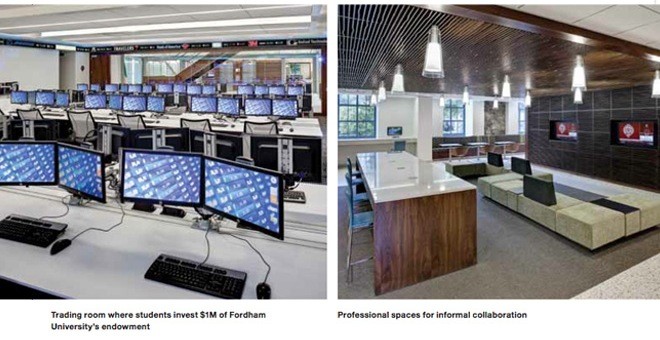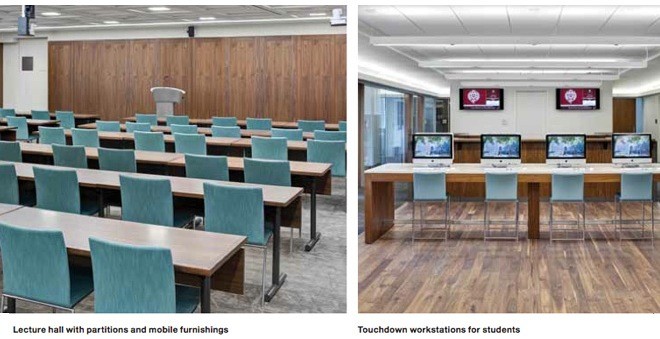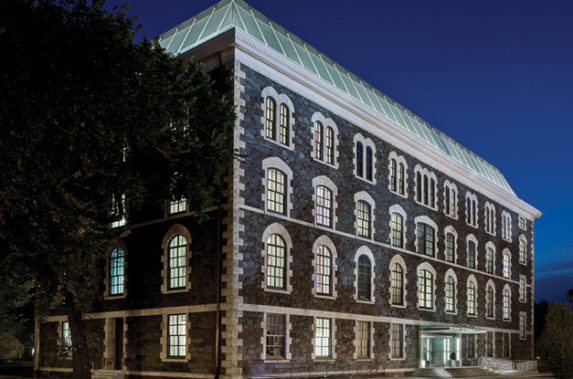Talk to an architect. Fordham University, challenged with the relocation and consolidation of its undergraduate business school, made the unusual decision to collaborate with a multi-disciplinary design practice known for its creative workplace solutions. HLW International is the designer behind many of Google’s high-energy, highly original offices. Gone are the days of cubicles surrounded by white walls and lit by white florescent lights, but gone also is the traditional classroom with its neat rows of desks and passive students.
“It was a gutsy direction to take the new building, but one entirely in line with Fordham’s long tradition of applied learning and nurturing the well-rounded, independent thinker,” said Donna Rapaccioli, Ph.D., dean of the Gabelli School of Business. She explained, “A Jesuit education emphasizes being attentive to experience, followed by reflection and analysis, and ultimately thoughtful action. Consequently, our new school needed to be the kind of environment conducive to collaboration and the exchange of ideas.”

It was a gutsy direction to take the new building, but one entirely in line with Fordham’s long tradition of applied learning and nurturing the well- rounded, independent thinker,” said Donna Rapaccioli, Ph.D., dean of the Gabelli School of Business.
“People immediately recognize Hughes Hall as a business school, from the moment they walk through the doors,” Rapaccioli continued. “It was important to the university that the spaces feel and function like a modern corporate facility, to give the students real life experience.” She added, “corporate but also homey.”
HLW, a New York City based design practice with offices around the world, won the bid, in part, because of its significant experience designing trading floors and offices for such heavy hitters as JPMorgan Chase and the New York Stock Exchange. HLW partner Jennifer Brayer sees her firm’s expertise with both educational and financial services environments as the “perfect bookends” for approaching a project like the $38M gut renovation and transformation of a historic campus building into a contemporary business school.
The new Hughes Hall retains its French gothic façade, built in 1891. However, with jewel-like precision, contemporary design elements are married with the original stonework. These include an abundant use of glass, the integration of technology, and a midcentury modernist sensitivity to clean simplicity, open spaces, organic hues and textured materials. Wide marble steps lead up to sliding glass doors under a clean-lined glass canopy. Upon entering the lobby, one’s eyes are immediately drawn toward the trading room. The majority of rooms in Hughes Hall include transparent materials, which is consistent with the current design trend for corporate facilities to physically portray institutional transparency. Nevertheless, the glass enclosed trading room is something special. It features Bloomberg terminals and streaming stock tickers. A video wall can be programmed to track how the Student Managed Investment Fund is performing. The trading room’s glass wall possesses a “smart film,” which can transform from clear glass to digital images.
The completed project represents a dramatic shift in uses. Key goals included creating flexible spaces for the latest learning technologies, dynamic special event spaces, and a variety of options for collaborating both formally and informally. Hughes Hall now houses six meeting rooms, three conference rooms, multiple student lounge areas, including one encircled by faculty offices, and a 160-seat lecture hall. The classrooms include video conferencing capabilities. For the majority, this involves a camera-tracking system, which follows faculty about the classroom and can stream lectures to remote locations in real time or to be edited at a later date. Smart Boards with interactive screens similarly allow faculty and students to edit and save lectures on their laptops. “These are the same technologies being embraced by forward-thinking companies who perceive technology as a natural extension of their ability to communicate ideas and collaborate,” said Brayer.
Dean Rapaccioli sees the new building as supporting the business school’s core mission of enabling the next generation of leaders to hone their integrative problem solving skills within, specifically, a team. She favors experiential learning, typically in small group arrangements, because, unlike the traditional “chalk and talk” lectures, the knowledge transfer is more effective—and relevant. Preparing business students for the complexities of the real world entails learning to function and collaborate in multidisciplinary ways.

“These are the same technologies being embraced by forward- thinking companies who perceive technology as a natural extension of their ability to communicate ideas and collaborate.” said Brayer.
This reality is behind why architects, like HLW, who are on the cutting-edge of corporate interior design, give their clients so many options for working. From customizable workstations and phone booths to huddle rooms and café meeting spaces, it’s all about the range of choices available and dependent upon the desired level of privacy and visibility. At Hughes Hall, the strategic positioning of pantries, stairwell landings and breakout spaces fosters spontaneous collaboration.
In the classroom, this approach manifests in a similar atmosphere of flexibility and adaptability. “We wanted to be able to ‘change our minds’ in the middle of class,” Rapaccioli explains. “A large group should have the ability to breakout into small group arrangements for team projects, but quickly regroup when needed.” Hughes Hall’s classrooms include tiered seating, for an intimate feel, but capable of accommodating a large group, and “flat floor,” open plans with mobile furniture. “It was crucial that the furnishings be light, comfortable…and have wheels!”
Hughes Hall also houses the Center for Global Studies, which is fitting for a business school that aims to cultivate an inclusive, international perspective on the marketplace. “To reach the top echelon of the business world, a person needs to know more than business itself,” asserts Rapaccioli. She cites the need to “write and speak compellingly and persuasively,” to understand other cultures, and, most importantly, to be exposed to alternative ideas, methods and approaches.
The new Hughes Hall provides students with a platform for practicing the necessary skills to achieve these goals. Brayer describes a “meeting of the minds” when alluding to the collaboration between her firm and Fordham. She states, “If you are going to define innovation in today’s workplace as taking a progressive idea and making it replicable, applicable and, ultimately, valuable in a totally different situation…well, then, a successful design solution is about creating spaces that spur just that kind of innovation…and this involves getting people to work together.”

